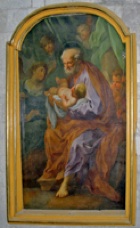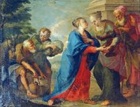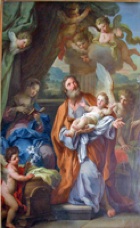Sebastiano Conca, who was born in Gaeta, in the Kingdom of Naples, moved to Rome in 1706 to train as an artist. He subsequently became one of the most successful painters in Rome, where his patrons included Cardinal Pietro Ottoboni. Pope Clement XI commissioned him to paint an altarpiece for San Giovanni Laterano, Rome [when?] and subsequently knighted him. His most important commissions included the ceiling fresco (1721-4) of Cecilia in Glory in the newly restored basilica of Santa Cecilia in Trastevere. He was elected as a member of the Accademia di San Luca in 1718 and twice served as its director (in 1729-31 and again 1739-41). He published a guide to painting entitled “Ammonimenti” (Admonishments) in 1739.
Sebastiano Conca returned to Naples in 1752, and spent the remainder of his career there.
His students included Tommaso Conca, who was the son of one of his cousins, and Gaetano Lapis. Giuseppe Reposati, who trained in Rome under the latter for some twelve years from ca. 1740, also frequented the circle of Sebastiano Conca at this time.
Foligno
Madonna and Child with Saints (1752)
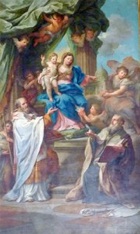
Gubbio
St Francis receiving the Portiuncula Indulgence (ca. 1733)
This altarpiece on the high altar of San Benedetto is signed by Sebastiano Conca. It was probably painted in 1733, just before the altar was was consecrated. The altarpiece depicts St Francis’ vision of the Risen Christ and the Virgin in the Cappella del Portiuncula as an angel offers him roses that have miraculously bloomed in winter.
Perugia
Visitation (18th century)
Panels from Palazzo Della Corgna, Città della Pieve (1731)
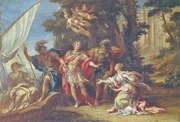
These two panels by Sebastiano Conca in the Galleria Nazionale depict scenes from the epic poem (1581), “La Gerusalemme Liberata” (Jerusalem Delivered) by Torquato Tasso. They depict:
-
✴the knight Rinaldo leaving the besotted witch Ermida on the island to which she has lured him (illustrated here); and
-
✴the Princess Erminia being cared for by shepherds.
Communion of St Mary Magdalene (1738)
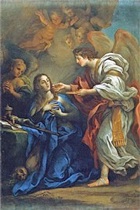
Spoleto
Works in or from Santa Maria della Manna d' Oro
Sebastiano Conca designed and/or painted three altarpieces for Santa Maria della Manna d' Oro, two of which survive in situ.
Rest on the Flight to Egypt (ca. 1735)

Annunciation (ca. 1735)

Birth of the Virgin (ca. 1735)
Other Works in the Museo Diocesano
The following works by Sebastiano Conca are also now in the Museo Diocesano.
Holy Family (ca. 1735)
St Joseph and the Baby Jesus (ca. 1740)
